Share

Forest Invest
Insuring forest assets with Gordon Steward
Understanding, evaluating, and avoiding or mitigating risk is a key component of any investment decision, and for forest assets it is no different. The difficulty lies where investors don’t understand (and often have inaccurate perceptions) of the risks associated with forest assets. Today, we’re joined by Gordon Steward, of Dual – Managing Director of Forestry. In our conversation, Gordon walks us through the ‘supply chain’ if you will of the insurance industry as it relates to his work with forests. He speaks to the most common geographies where forest insurance is prevalent and why, and describes the importance of sound forest management in reducing risk and making your assets more insurable.
Host: Shauna Matkovich - The Forest Link
Timecode
Details
00:07 Introduction to Gordon and Dual
03:07 How Dual insures forest assets - an NGA
04:09 The effect of climate change & forest fires
09:12 Biggest risks that concern investors
11:00 Fire or risk management plans are crucial
14:21 Carbon investment groups
15:44 Players in forestry insurance marketplace
15:43 Under pressure to make return for investors
21:04 Get the technical underwriting rate back to where it should be
22:58 Insurance classes and loss ratios
27:45 Financial insurance triggers to lessen the exposure to risk when investing in carbon products
28:24 Fire insurance cover
30:40 Legislation to protect nature and Indigenous people’s land rights
32:29 The use of trees
35:19 Final advice
Significant quotes:[24:30] “Forestry is a very what I term spiky business, so it is prone to catastrophic fire losses.”
[32:29] “The use of trees in so many industries and processes is quite unbelievable.”
[33:05] “Wood is so strong, and we make composites so strong now, it is stronger than bricks, it is much lighter and it is carbon friendly.”
Links mentioned:
Dual: https://www.dualgroup.com/
Sound Library:
- Nature by MaxKoMusic/Soundcloud
- Sopwell Woodlands and Scohaboy Bog SAC, Cloughjordan, Co Tipperary, IRELAND by wild_rumpus/Soundcloud
Sign up now for the ForestLink’s newsletter, where you’ll receive technical advice, reflections, and best-practice guidance to support you with your forest-linked investment strategy or business straight to your inbox.
More episodes
View all episodes
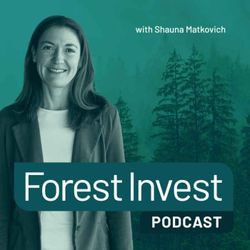
53. An Industrial Perspective on Forest Investment in Africa – with Hans Lemm
39:16||Season 2, Ep. 53Today, I’m joined by Hans Lemm, Director of Acacia Africa Advisors and former CEO of East Africa’s largest forest company. In this conversation, Hans shares lessons from over two decades of leading industrial forestry businesses across the emerging markets of Tanzania, Uganda, Kenya, Mozambique, and South Sudan. We explore what’s changed and what hasn’t in African forestry, from the growing role of smallholder farmers to the influx of Asian processing investment. Hans offers practical insights on managing operational and reputational risks, outlines investor misconceptions, and explains why inclusive value chains and realistic projections are key to successful forest investment. We also talk about the critical (but often misunderstood) role of carbon finance and the job-creation potential of forest industrialization.QuoteAfrica is generally a good place to grow trees. Trees grow fast here, and there are appealing fundamentals like a growing middle class and urbanization—but it remains a complex operating environment.Despite assumptions, I’ve never seen real problems around political risk or land tenure in my 20+ years of experience across the region. The risks are different than people often think.Useful ResourcesThe ForestLink newsletter signupHans Lemm on LinkedInProduction TeamFounding Director and Host: Shauna Matkovich - The ForestLinkProducer and Editor: Magdalena Laas - Unscripted CreativesChapters00:00] Introduction – Meet your host, Shauna Matkovich[00:19] Guest intro – Hans Lemm of Acacia Africa Advisors[01:12] Hans’s journey: 25 years in African forestry[03:08] How Africa’s forest sector has changed – and what hasn’t[04:12] More than just planting: The need for downstream investment[05:14] The role of smallholder tree farmers[06:27] What happens when industrial capacity lags behind wood supply?[07:16] Rise of Asian investors and local processing[08:27] Domestic markets: Still largely informal[09:37] What still needs to change: Standards, logistics & regulation[11:11] Ingredients for a sustainable forestry business[13:01] Real vs. perceived investment risks[15:06] Taxation and technical missteps – hidden threats[17:06] Local knowledge matters – even within small regions[18:02] Forex, investor fatigue & reputational concerns[19:09] Aligning operators and investors for long-term success[21:52] Reporting pressure in emerging markets[24:08] The role of DFIs in African forestry[26:32] Key market drivers: Trade with Asia, local manufacturing[28:14] Carbon finance: Tool or trap?[30:07] Forestry as a job engine and community license to operate[33:01] Field story: The cobra in Uganda[33:19] Mentorship and career-defining moments[34:54] Evacuation in South Sudan – and the best beer ever[37:04] What’s next for Hans Lemm[38:00] Final advice to investors: Be realistic[38:41] Where to find Hans Lemm online[39:00] Outro – Thanks from Shauna MatkovichSound LibraryNature by MaxKoMusic/SoundcloudSopwell Woodlands and Scohaboy Bog SAC, Cloughjordan, Co Tipperary, IRELAND by wild_rumpus/SoundcloudAmbient Documentary by Sound Guru (Pixabay)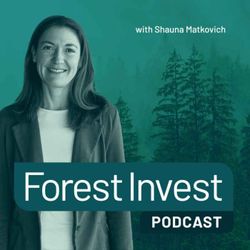
52. Securitization in Emerging Market Forest Investment with Alessandro Materni
47:39||Season 2, Ep. 52Alessandro Materni, Managing Partner at FLS Forestry Linked Securities, joins me on The Forest Investment Podcast. Today, we explore how securitization can revolutionize forest investment in the Global South, making it more accessible to institutional investors. Alessandro breaks down the mechanics of forestry-backed securities, the unique advantages of reforestation in Paraguay, and the safeguards needed to mitigate ESG and political risks. We also discuss FLS's mission-driven strategy, seeking long-term investor returns with biodiversity, climate, and social impact goals. If you're interested in learning alternative approaches to structuring finance in a forest investment, this episode offers great lessons.QuoteWe try to shield assets from political risk and local idiosyncrasies as much as possible, to make them securitizable, and ultimately investable.Useful ResourcesThe ForestLink newsletter signupAlessandro Matterni LinkedInFLS Forestry Linked SecuritiesFLS on LinkedInStrawberry tree (Arbutus unedo) & Lapacho (Handroanthus impetiginosus)Production TeamFounding Director and Host: Shauna Matkovich - The ForestLinkProducer and Editor: Magdalena Laas - Unscripted CreativesChapters[00:00] Introduction to Forest Invest with Shauna Matkovich[00:21] Meet the Guest: Alessandro Materni of FLS[00:35] Alessandro’s Favorite Trees: Strawberry Tree & Lapacho[02:05] Introduction to Alessandro and FLS Forestry Linked Securities[04:45] Explaining Securitization in Forestry Terms[07:18] Rating Agencies & Forestry Assets[08:46] Scale of Institutional Forestry Investment[10:06] How FLS Aims to Expand Forestry Markets[12:15] Addressing Political Risk in Emerging Markets[13:49] Why Paraguay? Land, Governance, and Risk Mitigation[17:03] Target Wood Markets in Paraguay[18:35] ESG, Carbon Credits, and Conservation Commitments[21:20] Local Community Engagement and Biodiversity Practices[23:39] Reforestation vs. Mature Asset Strategy[24:39] Life Cycle of Forest Investment and Securitization Timing[27:02] Exit Options and Evergreen Structure[29:39] Investor Profiles and Suitability[32:12] Is This Strategy Right for Forestry Newcomers?[34:12] Non-Negotiable ESG Commitments[36:26] Why Securitization Is Less Common in Developed Markets[38:03] Other Potential Jurisdictions Beyond Paraguay[41:05] Carbon Markets and the Bigger Picture[45:12] Final Advice for New Forest Investors[46:17] Where to Learn More About FLS[47:23] Closing Remarks from ShaunaSound LibraryNature by MaxKoMusic/SoundcloudSopwell Woodlands and Scohaboy Bog SAC, Cloughjordan, Co Tipperary, IRELAND by wild_rumpus/SoundcloudAmbient Documentary by Sound Guru (Pixabay)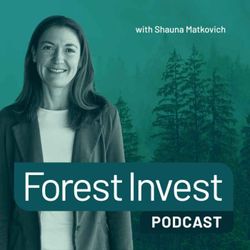
51. Characteristics of an Institutional Forest Investment Portfolio for Financial and Climate Objectives – with Olly Hughes and David Gardner
44:05||Season 2, Ep. 51Today, I’m joined by Olly Hughes, Managing Director of Forestry, and David Gardner, Chief Investment Officer for Forestry at Gresham House. In this discussion, we explore how Gresham House builds global forestry portfolios that incorporate both financial and climate-related considerations. Olly explains why timberland offers stable, inflation-linked returns and outlines how it fits into the “natural capital” asset class, where sustainable timber, carbon credits, and biodiversity gains converge. David adds rich insight into long-rotation conifer crops and how afforestation and compliance carbon markets (especially in Australia and New Zealand) can support early cash flow. We delve into the significance of establishing KPIs for biodiversity and why experiencing a forest firsthand can be the most effective education for new investors.Quote“We believe global timber demand will nearly triple over the next 30 years, so we must plant trees both for nature-based reasons and for timber supply.” – Olly Hughes “Certification is just the starting point—we manage to global standards and then layer on sustainability objectives to meet Article 9 criteria.” – David GardnerUseful ResourcesGresham HouseOlly Hughes (LinkedIn)David Gardner (LinkedIn)The ForestLink newsletter signupFavorite trees: Walnut (Juglans regia) & Ginkgo BilobaProduction TeamFounding Director and Host: Shauna Matkovich - The ForestLinkProducer and Editor: Magdalena Laas - Unscripted CreativesChapters[00:00] Intro & Welcome[00:35] Favorite Trees[01:19] Introductions & Gresham House Overview[04:19] Why Forestry? Key Investment Benefits[08:52] Case Study: Forestry Resilience During Recession[10:47] Climate Goals & Misconceptions[15:37] Policy Regulations & Market Impact[18:08] Best Geographies Where Climate and Returns Align[22:33] Portfolio Strategy – Mixing New and Mature Assets.[24:10] Carbon Markets 101[27:02] Timber vs. Carbon Returns[29:01] Nature & Biodiversity Investing[36:59] Managing Forests & Funds, Sustainability Meets Scalability.[39:02] Global Standards for Nature and Carbon[39:26] Inspiration & Frustration[42:00] Final Advice[43:13] Closing & Contact InfoSound LibraryNature by MaxKoMusic/SoundcloudSopwell Woodlands and Scohaboy Bog SAC, Cloughjordan, Co Tipperary, IRELAND by wild_rumpus/SoundcloudAmbient Documentary by Sound Guru (Pixabay)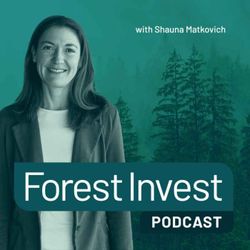
50. Collaborating for Forest Production and Restoration at Scale – with Charlotte Kaiser and Esben Brandi
42:23||Season 2, Ep. 50Today, I’m joined by Charlotte Kaiser, Head of Impact Finance, and Esben Brandi, Head of Business Development at BTG Pactual Timberland Investment Group (TIG). In this episode, we explore how TIG is collaborating with Conservation International and The Nature Conservancy to achieve ambitious climate and biodiversity outcomes. We discuss the operational integration of production forestry and restoration components in Latin America, boosting forest resilience through tweaks in management across U.S.-based assets, and how trusted environmental collaborators help address reputational concerns while building investor confidence. Charlotte and Esben share insights into evolving investor expectations, the role of science-based planning, and how these structured NGO engagements support both performance and purpose across forest landscapes.Quotes"Each institution needs to make the other partner’s goals and challenges their own so that we can become a single team working toward a shared set of outcomes.” - Charlotte“It’s a very healthy and worthwhile process to sit in the same room and work through different objectives to maximize both impact and financial success.” - EsbenUseful ResourcesBTG Pactual Timberland Investment GroupCharlotte Kaiser (LinkedIn)Esben Brandi (LinkedIn)BTG Pactual Timberland Investment GroupThe ForestLink newsletter signupProduction TeamFounding Director and Host: Shauna Matkovich - The ForestLinkProducer and Editor: Magdalena Laas - Unscripted Creatives[00:14] Welcome and introduction to the guests[00:39] Favorite trees of Charlotte and Esben[01:56] Quick bios and roles at TIG[03:45] Introduction to TIG and its client base[05:35] Notable corporate collaborations, including Apple[06:58] Why TIG collaborates with environmental NGOs[08:10] Roles of The Nature Conservancy and Conservation International[10:18] Investor sentiment and current demand[11:42] Differences in engagement models: North America vs Latin America[13:36] Asset-level monitoring and biodiversity interventions[17:14] Land sparing strategy and integration of restoration[18:08] Specific impact targets for restoration and carbon[19:32] Governance structures with NGO partners[22:15] Balancing NGO goals with investor needs[26:46] Navigating trade-offs and alignment of objectives[30:10] External stakeholder feedback and carbon buyers' interests[33:33] Key results: carbon deals, restoration milestones, endangered species sightings[36:23] Restoration R&D in the Cerrado biome[37:58] Key lessons from cross-sector collaboration[38:35] What’s next for TIG[40:36] Actionable advice for new forest investors[42:10] Where to learn more about TIG’s workSound LibraryNature by MaxKoMusic/SoundcloudSopwell Woodlands and Scohaboy Bog SAC, Cloughjordan, Co Tipperary, IRELAND by wild_rumpus/SoundcloudAmbient Documentary by Sound Guru (Pixabay)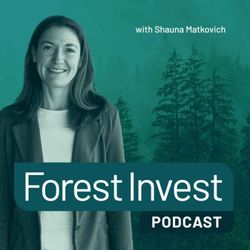
49. Corporate Forest Investment via the Future Forest Innovations Fund – with Geoffrey Seeto
48:24||Season 2, Ep. 49In this episode, I’m joined by Geoffrey Seeto, Senior Managing Director and Head of Emerging Markets at New Forests, to discuss the Future Forest Innovations Fund — a global, open-ended forestry vehicle co-developed with Oji Holdings. Geoffrey explains how the Fund aims to meet climate targets through a high-integrity insetting strategy and achieve full FSC certification across its portfolio. We explore how the open-ended structure supports long-term forest stewardship and enables net carbon sequestration under the GHG Protocol and steady timber returns. Geoffrey also shares how corporate capital is driving forest expansion in emerging markets and reshaping the future of forest finance.Quote"An open-ended structure allows us to steward forests into perpetuity, which is critical for both carbon permanence and long-term timber value creation."Useful ResourcesThe ForestLink newsletter signupGeoffrey Seeto on LinkedInNews: New Forests partners with Oji Holdings to establish a forestry fund to help meet 2030 goalsFavorite tree: EucalyptusProduction TeamFounding Director and Host: Shauna Matkovich - The ForestLinkProducer and Editor: Magdalena Laas - Unscripted CreativesChapters[00:00] Welcome & Guest Introduction[00:35] Geoffrey's Favorite Tree[01:25] Geoffrey’s Role at New Forests[02:15] Emerging Markets vs. Developed Markets[03:55] Positive Impact & Mixed Landscape Approach[05:12] Introduction to the Future Forest Innovation Fund (FFI)[05:34] Origins of the OG Partnership[06:58] High Sustainability Standards & FSC Certification[07:53] OG's 2030 Climate Goals & Role of New Forests[08:51] Vertical Integration & Local Economic Impact[10:13] Defining “Innovation” in FFI[11:18] Permanent Capital Vehicle Explained[12:56] The Case for Investing in Emerging Markets[13:25] Why Open-Ended Funds Work for Forestry[15:34] Institutional Appeal & Long-Term Stewardship[17:23] African Fund & Perpetual Management[18:44] Building a Global Forestry Portfolio[22:01] Regional Allocation Breakdown[23:38] Why Latin America is Next[25:00] Asset Characteristics: Species, Maturity & Market Access[28:03] Certification: FSC, Carbon Standards, and SFDR[30:20] Carbon Insetting vs. Offsetting[32:28] OG’s Role & Future Investors[35:30] Corporate vs. Institutional Investors[38:35] Voluntary Carbon Markets & Paris Targets[40:25] Meeting Different Investor Needs[41:36] Lessons from Infrastructure & Forestry Growth[43:42] Final Advice for New Investors[47:25] Where to Learn More[48:00] Closing RemarksSound LibraryNature by MaxKoMusic/SoundcloudSopwell Woodlands and Scohaboy Bog SAC, Cloughjordan, Co Tipperary, IRELAND by wild_rumpus/SoundcloudAmbient Documentary by Sound Guru (Pixabay)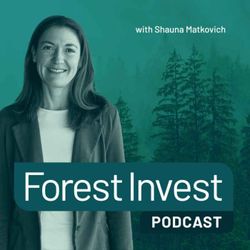
48. Forest Investment via Continuous Cover Forestry (CCF) – with Darius Sarshar
45:44||Season 2, Ep. 48Today, I am joined by Darius Sarshar, Principal at SLM Partners. In this episode, Darius makes a compelling case for Continuous Cover Forestry (CCF) as a regenerative, climate-resilient alternative to clear-fell forest management models. We explore when CCF makes sense and how it delivers both strong financial returns and meaningful ecological benefits, boosting IRRs, enhancing biodiversity, and generating carbon credits. By maintaining a permanent forest canopy, CCF enhances resilience to storms, drought, and pests, while fostering natural regeneration. From a financial perspective, it evens out and brings forward timber revenues, generating earlier, steadier cash flows. This episode is essential for investors seeking a smart, nature-aligned approach to timberland.Quote"Continuous cover forestry is about managing complexity—with biodiversity, resilience, and timber income all improving over time. It’s not just sustainable—it’s sensible."Useful ResourcesThe ForestLink newsletter signupSLM PartnersWhite Paper: Investing in Continuous Cover Forestry (CCF) in EuropeDarius Sarshar on LinkedInFavorite tree: Sitka Spruce (Picea sitchensis)Production TeamFounding Director and Host: Shauna Matkovich - The ForestLinkProducer and Editor: Magdalena Laas - Unscripted CreativesChapters[00:00] Welcome & Introduction[00:31] Darius’ Favorite Tree: Sitka Spruce[01:44] Darius’ Career Journey & About SLM Partners[04:11] Emerging vs. Core Markets: Lessons from the Tropics[05:24] Why Europe Is Underrepresented in Forest Investment[08:12] Challenges & Opportunities in European Forestry[11:08] Intro to Continuous Cover Forestry (CCF)[13:39] Where is CCF Applicable? Site & Species Suitability[16:04] Policy, Regulation & Societal Drivers for CCF[18:01] Why SLM Adopted CCF: Research & Evidence[19:52] Financial Performance: CCF vs. Clearfell[23:54] Monocultures to Mixed Forests: The Transition Strategy[25:40] Carbon Benefits & Carbon Credit Eligibility[28:55] Timber + Carbon Strategy: Is the Regime Different?[30:42] Active Management Benefits: Timber, Carbon & Biodiversity[33:14] Social Impact of CCF: Jobs, Communities, and Recreation[35:44] Addressing Concerns: Disturbance & Soil Compaction[39:07] Investor Education: Risk, Data & Demand for Authenticity[42:14] Final Reflections & The Growing CCF Movement[44:33] Darius’ Actionable Advice to New Forest Investors[45:28] Closing & Next Episode TeaserSound LibraryNature by MaxKoMusic/SoundcloudSopwell Woodlands and Scohaboy Bog SAC, Cloughjordan, Co Tipperary, IRELAND by wild_rumpus/SoundcloudAmbient Documentary by Sound Guru (Pixabay)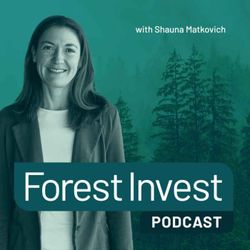
47. Sustainable Forest Management in Production Forests – with Marcos Wichert
38:18||Season 2, Ep. 47Today I’m joined by Marcos Wichert, Vice President, Plantation Forest and Sustainability Management at Stora Enso. Marcos shares his international journey across Brazil, China, New Zealand, and Finland, exploring how sustainable forestry must adapt to local regulations, ecosystems, and social expectations. We delve into the role of catchment-based planning, biodiversity KPIs, and the dos and don'ts of Eucalyptus. From certification standards to boardroom sustainability strategy, Marcos offers practical insights for investors looking to align profitability with climate and nature goals.Quote“Sustainable forestry means managing commercial forests at a landscape level, with the catchment area as the key management unit to monitor and guide the impacts of forestry activities.”Harvest less than the forest grows each year, and that’s a basic principle of sustainable forestry."Useful ResourcesThe ForestLink newsletter signupMarcos on LinkedInIndicators - Biodiversity | Stora EnsoBiodiversity indicators for plantations - Biodiversity | Stora EnsoSpecies Threat Abatement and Restoration (STAR) metricInvestor News: Stora Enso partners with IUCN to advance positive impacts on biodiversityProduction TeamFounding Director and Host: Shauna Matkovich - The ForestLinkProducer and Editor: Magdalena Laas - Unscripted CreativesTime Stamps/Chapters[00:00] Introduction [01:00] Marcos' Career Journey [03:45] What is Sustainable Forestry? [05:20] Global Examples of Sustainable Practices [09:10] Plantation vs. Natural Forest Management [12:00] Key Considerations for Forest Investors [15:30] The Truth About Eucalyptus [21:30] Forest Management Across Spatial and Temporal Scales [28:30] Sustainability in the Boardroom [31:30] Nature-Positive Commitments by Large Companies [33:40] Sustainability for Public Market Investors [36:20] Final Reflections and Where to Learn MoreSound LibraryNature by MaxKoMusic/SoundcloudSopwell Woodlands and Scohaboy Bog SAC, Cloughjordan, Co Tipperary, IRELAND by wild_rumpus/SoundcloudAmbient Documentary by Sound Guru (Pixabay)
46. Investing at the Intersection of Traditional Forest Investment and Nature-Based Solutions - with Margaret Morales
45:14||Season 2, Ep. 46This episode flips the usual format. Instead of hosting, I’m the one being interviewed by Margaret Morales during a live webinar, which is now being shared with you in this special release. We dive into the evolving landscape of forest investment, where carbon and timber strategies increasingly overlap with climate and impact goals. I share what I’ve learned from advising asset managers and project developers across geographies: from return expectations and capital stacks to risk mitigation and community engagement. If you're navigating nature-based solutions and forest finance, this conversation is full of practical insights.Quote"If you're not talking about risk early on, that’s a red flag. Every project has risk—it’s how you acknowledge and plan for it that matters."Useful resourcesMargaret Morales on LinkedInTrellis (the company where Margaret is a director)Alexandra Holmlund (Biodiversity credit methodologies)The ForestLink newsletter signupProduction TeamFounding Director and Host: Shauna Matkovich - The ForestLinkProducer and Editor: Magdalena Laas - Unscripted CreativesTime Stamps[2:07] Shauna’s background – from forester to investment professional[4:11] Types of clients Shawna works with (traditional vs. new investors)[6:14] Return expectations in forest investments[7:38] Multi-revenue stream projects – timber + carbon[10:11] Carbon as a “sweetener” in early-stage projects[12:20] Timeline expectations – 10 to 15 years typical hold period[13:50] Explaining greenfield vs. brownfield forest projects[16:57] Growing interest from new climate-focused investors[18:47] Geographic trends in forest investments[20:40] Afforestation projects: high impact, high capital need[21:22] How developers can solve early-stage funding gaps[25:45] Typical capital stack in forest funds[27:40] Blended finance and concessional capital in forest investment[30:00] Why debt is rare in early forest projects[31:33] Biodiversity credits – demand, challenges & local approaches[34:44] Sustainable community credits & the role of community[36:49] What investors want to see on community engagement[37:09] Pure carbon funds – challenges and exit strategy concerns[40:53] Biodiversity credit methodologies (e.g. Alexandra Holmlund's work)[42:23] Carbon price projections – conservative modeling adviceSound LibraryNature by MaxKoMusic/SoundcloudSopwell Woodlands and Scohaboy Bog SAC, Cloughjordan, Co Tipperary, IRELAND by wild_rumpus/SoundcloudAmbient Documentary by Sound Guru (Pixabay)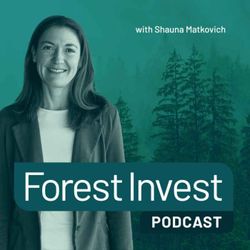
45. Investor Pulse Check: Top Timberland Challenges Revealed – with Tracy Buran Evens
46:02||Season 2, Ep. 45Today, I’m joined by Tracy Buran Evens, Principal of TimberLink, who shares insights from a recent survey capturing the biggest challenges facing institutional Timberland investors today. We unpack the top themes that emerged from both asset managers and investors—return expectations, macroeconomic pressures, ESG obligations, strategy, and valuation concerns. Tracy explains why there’s a disconnect between stumpage prices and timberland valuation, the flood of new climate-focused capital, and how different fund structures are suiting different investor types. Whether you’re new to forest investing or a seasoned pro, this episode offers a reality check and a roadmap for navigating today’s Timberland landscape.Quote“This is really a sea change—almost $10 billion in new capital has been committed to timberland, much of it targeting natural capital and climate-based solutions.”Useful ResourcesTimberlinkTracy’s email: tevens@timberlink.netTracy on LinkedInFavorite tree: Ginkgo Biloba treeProduction TeamFounding Director and Host: Shauna Matkovich - The ForestLinkProducer and Editor: Magdalena Laas - Unscripted CreativesTime Stamps01:03Overview of Timber Link02:58Recent survey for investors and TIMO’s - what is the biggest challenge you face with your timberland portfolio?09:36Five key themes in responses11:05Do TIMO’s have insight into clients’ struggles?12:50Any follow-up questions?13:49Are timberland allocations decreasing, increasing, or staying the same?18:16Clarification about the seeming discrepancy between investor concerns about returns and new investors and capital who seek new assets?22:15The challenge of the difference between timberland valuation and timber prices - is the market saturated or is the climate spin creating new assets?26:02Consolidation in smaller plots?27:06How does this tie into the challenge of valuations?29:47What caveats should new investors consider, and how can these concerns be addressed?31:55ESG concerns (incl. carbon credits and biodiversity calculations and reporting)37:40Thoughts on approaches to investing in forests40:33Evergreen vs. closed-end structures?42:58Concerns around uncertainty in the macroeconomic environment 44:45Actionable advice to new investors45:37Contact detailsSound LibraryNature by MaxKoMusic/SoundcloudSopwell Woodlands and Scohaboy Bog SAC, Cloughjordan, Co Tipperary, IRELAND by wild_rumpus/SoundcloudAmbient Documentary by Sound Guru (Pixabay)